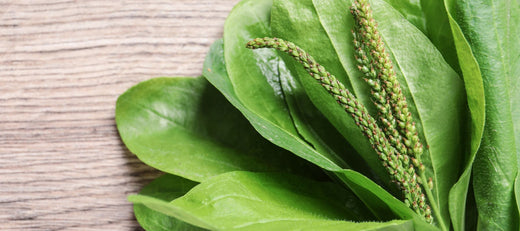When you hear the word ‘plantain,’ you might think of the starchy fruit related to the banana, but Broadleaf Plantain is something entirely different. Also known as Common Plantain (Plantago major), it is a small, unassuming plant often mistaken for a weed. Despite its humble appearance, it’s a powerful medicinal herb with a rich history, deserving a place in the survivalist’s medicine cabinet and herb garden. I’ve experienced its benefits firsthand. A few years ago, I had a severe case of poison ivy, and a friend made an ointment from plantain leaves for me. The rash was miserable, but her soothing remedy relieved the itch and helped my skin heal quickly. Rather than seeing this beneficial plant as a nuisance, consider embracing plantain for its usefulness and giving it a dedicated space in your herb garden.
An Herb with Deep Roots
Plantain is sometimes called “White Man’s Footprint” because it spread wherever Europeans settled. Indigenous peoples across North America noted how it would expand rapidly in disturbed soils, an uninvited yet persistent guest that seemed to follow the settlers’ tracks. Robin Wall Kimmerer writes, “In indigenous cultures, we don't see plants as weeds; we see them as gifts of healing and food, as teachers.” The Native American people saw common plantain as more than a weed, but as a plant with valuable lessons and gifts to offer. With this wise perspective to draw from, they quickly learned how to incorporate this newcomer into their healing arts.
Medicinal Benefits of Broadleaf Plantain
Common plantain is so useful that it has earned the nickname “nature’s band-aid.” The leaves are rich in mucilage, tannins, and allantoin, making them ideal for soothing irritated skin and promoting wound healing. A simple poultice made by chewing or crushing fresh leaves can be applied directly to insect bites, cuts, or stings to reduce pain and inflammation. On a hike or in a survival situation, this quick remedy can be a lifesaver when other medical supplies are unavailable.
In addition to its healing properties for skin and wound care, this herb also has internal applications. A tea made from the leaves is known to support respiratory health, ease digestive issues, and even act as a mild diuretic. The seeds, when harvested and dried, can be used as a gentle fiber supplement similar to psyllium husk.
Where to Plant Common Plantain

As with other “medicinal weeds” that are taken for granted, it can feel strange to dedicate a spot to a plant that will happily grow in the cracks of your driveway. Creating a designated spot in your garden gives you a steady supply of leaves for your herbal remedies. By growing your own, you can ensure that your plants are grown in soil that isn’t polluted or contaminated, giving you a safe source of uncontaminated leaves for medicinal use.
Broadleaf plantain is incredibly adaptable and can thrive in a variety of conditions, making it an excellent addition to any garden aimed at self-sufficiency. It tolerates compacted soils, poor drainage, and a range of light levels, from full sun to partial shade. This makes it an excellent choice for any area of the garden with poor soil that you want to improve. Its deep taproot helps break up compacted ground, making it a valuable pioneer plant in tough conditions. However, it does have the potential to become invasive, so keep that area well contained to help manage the spread and don’t allow it to grow unchecked. By growing it in designated garden beds or containers, you can enjoy its benefits without worrying about it overrunning your other green spaces.
Growing Broadleaf Plantain from Seed
To get started growing this medicinal herb, scatter seeds directly on the soil surface in early spring or late fall, gently pressing them into the ground. The seeds will germinate easily within about 2 weeks. Keep the soil moist until they sprout, usually in about two weeks. Once established, plantain requires almost no maintenance at all, thriving even when it is neglected. It’s highly adaptable to dry, hot weather and drought conditions.
Harvesting Plantain for Medicinal Use

You can pick plantain leaves throughout the growing season as needed. Choose younger, tender leaves for fresh use and the older, tougher ones for drying. The seeds can be collected when the stalks turn brown and begin to dry out in late summer. Store both leaves and seeds in a cool, dry place for use throughout the year.
Wisdom from Plants
Even the most overlooked plants have value as long as they are grown thoughtfully in the right space. Plantain’s presence in the garden can be a reminder of the interconnectedness we have to all of nature. As Robin Wall Kimmerer reminds us, “Plants know how to make food from light and water, how to clean the air, how to heal themselves. What if they could teach us to do the same?”
By growing and using broadleaf plantain, we tap into a deeper knowledge of healing that has been with us for centuries, one that invites us to see the world—and the so-called weeds around us—with new eyes. In a time when resilience and self-sufficiency are more important than ever, plantain offers an opportunity to cultivate both. We invite you to add it to your herb garden and embrace a tradition of natural healing that survivalists have relied on for centuries. Plant some seeds and see the benefits for yourself.

























